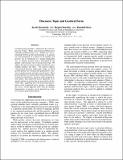Discourse Topic and Gestural Form
Author(s)
Eisenstein, Jacob; Barzilay, Regina; Davis, Randall
DownloadEisenstein_Discourse topic.pdf (282.5Kb)
PUBLISHER_POLICY
Publisher Policy
Article is made available in accordance with the publisher's policy and may be subject to US copyright law. Please refer to the publisher's site for terms of use.
Terms of use
Metadata
Show full item recordAbstract
Coverbal gesture provides a channel for the visual expression of ideas. While some gestural emblems have culturally predefined forms (e.g., "thumbs up"), the relationship between gesture and meaning is, in general, not conventionalized. It is natural to ask whether such gestures can be interpreted in a speaker-independent way, or whether gestural form is determined by the speaker's idiosyncratic view of the discourse topic. We address this question using an audiovisual dataset across multiple speakers and topics. Our analysis employs a hierarchical Bayesian author-topic model, in which gestural patterns are stochastically generated by a mixture of speaker-specific and topic-specific priors. These gestural patterns are characterized using automatically-extracted visual features, based on spatio-temporal interest points. This framework detects significant cross-speaker patterns in gesture that are governed by the discourse topic, suggesting that even unstructured gesticulation can be interpreted across speakers. In addition, the success of this approach shows that the semantic characteristics of gesture can be detected via a low-level, interest point representation.
Date issued
2008Department
Massachusetts Institute of Technology. Computer Science and Artificial Intelligence Laboratory; Massachusetts Institute of Technology. Department of Electrical Engineering and Computer ScienceJournal
Proceedings of the 23rd national conference on Artificial intelligence - Volume 2 (AAAI '08)
Publisher
Association for Computing Machinery (ACM)
Citation
Jacob Eisenstein, Regina Barzilay, and Randall Davis. 2008. Discourse topic and gestural form. In Proceedings of the 23rd national conference on Artificial intelligence - Volume 2 (AAAI'08), Anthony Cohn (Ed.), Vol. 2. AAAI Press 836-841. © 2008, Association for the Advancement of Artificial Intelligence
Version: Final published version
ISBN
978-1-57735-368-3